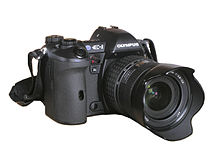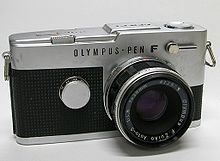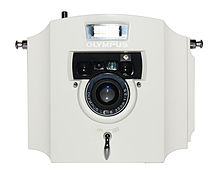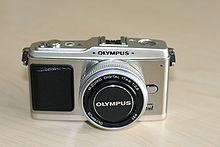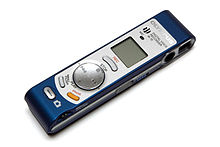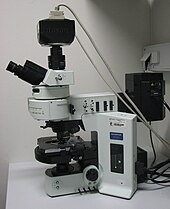Olympus
| Olympus
|
|
|---|---|
| legal form | Kabushiki-gaisha (joint stock company) |
| ISIN | JP3201200007 |
| founding | October 12, 1919 |
| Seat | Shinjuku , Tokyo , Japan |
| management | Yasuo Takeuchi (CEO) |
| Number of employees | 35,000 (2019) |
| sales | 794 billion yen ( € 6.34 billion ) (2019) |
| Branch | Optical and photo industry |
| Website | olympus-global.com |
The company Olympus KK ( Jap. オリンパス株式会社 , Orimpasu Kabushiki-gaisha , Eng. Olympus Corporation ), listed on the Nikkei 225 , one is Japanese manufacturer opto- digital products for business and leisure as well as for medicine, science and industry.
history
Emergence
On October 12, 1919, the lawyer Takeshi Yamashita and his partner Shintaro Terada founded the Takachiho Seisakusho company . Takachiho stands for a mountain in Japan, on the summit of which according to Japanese mythology the gods live. The later name Olympus, which was first introduced as a brand name in 1921 and as the official company name from 1949, was chosen in the course of expansion based on the Greek mountain of gods , as this term was more internationally known.
Initially, the products included microscopes and, until 1923, thermometers. In 1935 the Mizuho Optical Research Center was opened to research camera lenses.
International expansion and expansion of the medical sector
From the 1960s onwards, companies were successively founded around the world, including the European headquarters Olympus Europa GmbH (1963), the North American headquarters Olympus Corporation of America (1968) and various other regional branches, most recently Olympus Belgium (2004).
A research and development contract was signed in 1975 with the Hamburg manufacturer of minimally invasive endoscopy systems , Winter & Ibe . The two companies cooperated from then on, and in 1979 Olympus finally took a majority stake in the company, which from then on operated as Olympus Winter & Ibe GmbH . This laid the foundation for the Olympus Surgical Business .
The British medical technology provider Keymed Ltd. to the Olympus Group, one year later also to Son Ciné Optique Photo SA in France.
A strategic alliance was formed in 1992 with the manufacturer of medical technology, Ethicon Endo Surgery . In 1993 Flemming GmbH joined the Olympus group. The Olympus Diagnostica GmbH , a provider of diagnostic equipment in Umkirch , was founded in 1994, d. H. in the same year as Hamburg-based Olympus Software Europe GmbH . The service company Olympus Endo-Repair Europe GmbH was also founded in Hamburg in 1996 . The Olympus Medical Care Kft. Was founded in 2000 in Hungary. Olympus BioSystems GmbH , a manufacturer of imaging systems for biological applications , was founded in Planegg in 2001 . In 2004 a majority stake in Celon AG took place.
In 2005 Olympus took over Advalytix AG, a biotechnology company. In addition, Olympus Europa was reorganized under the umbrella of Olympus Europa Holding GmbH . The holding in 2006 received a Supervisory Board chaired by Hans-Joachim Winter.
In 2007, Olympus took over the British medical technology manufacturer Gyrus ACMI , and the research and development center Olympus Life Science Research Europa GmbH was opened. The following year the Olympus Medical Training Center opened at Olympus Winter & Ibe GmbH . The company Beckman Coulter took over in 2009, the Olympus Diagnostic GmbH.
Balance sheet scandal 2011 and reorientation of the group from 2020
A scandal broke out in 2011 when CEO Michael Woodford criticized the company's accounting and was subsequently fired. Woodford then published his findings and as a result the company had to admit falsified accounts. As a result, the Tokyo police opened an investigation into the allegation of concealment of losses in securities deals from the 1990s. It found that for more than a decade, investment losses of 117.7 billion yen (€ 1.17 billion, as of 2012) had been obscured in the balance sheet. Former company boss Tsuyoshi Kikukawa, an accountant and a top manager have tried the crime. The company got into a crisis, and in 2012 Sony acquired a large block of Olympus shares.
After Olympus celebrated its 100th anniversary in 2019, it was announced on June 24th, 2020 that Olympus wanted to part with its camera division. This would be sold to Japan Industrial Partners , a definitive contract is to be concluded in September 2020. The reason for the decision was that the camera division made losses for the group for three years in a row and at that time only contributed 5 percent of the group's sales. In the future, Olympus wants to concentrate almost exclusively on medical equipment.
Group structure
The corporate headquarters are located in Shinjuku , Tokyo, while the US headquarters for the Americas is in Center Valley , Pennsylvania . The European headquarters are in Hamburg, Germany.
Olympus in Europe
In Europe, the business is run by the wholly-owned subsidiary Olympus Europa Holding GmbH, based in Hamburg. The following companies are united under the umbrella of the holding company: Olympus Deutschland GmbH, Olympus Imaging Europa GmbH, Olympus Soft Imaging Solutions GmbH, Olympus Medical Systems Europa GmbH and Olympus Winter & Ibe GmbH.
Since April 1, 2010, Olympus has bundled its medical device areas for minimally invasive diagnostics and therapy in Europe under the umbrella brand Olympus Surgical Technologies Europe. These include the companies: Olympus Winter & Ibe GmbH, Celon AG, Olympus Medical Products Czech SPOL. SRO On January 1, 2011 Gyrus Medical GmbH followed under this roof and on April 1, 2011 Olympus Surgical UK followed.
In addition, Olympus is represented by sales, service and production companies in almost all European countries. The approximately 4,500 employees of the Olympus Europa Group - more than 1,500 of them work in Hamburg - achieved sales of 1.413 billion euros in the 2012/13 financial year.
Product range
The Olympus product portfolio includes analog and digital cameras such as the Olympus OM-D E-M1 and other cameras in the Micro Four Thirds standard . In addition, Olympus offers rigid and flexible endoscopes for medicine and industry, microscopes as well as high-speed video and NDT devices and is market leader in the field of digital dictation machines .
Cameras
35mm cameras
Viewfinder cameras
Olympus entered the photo market in 1936 with the "Semi-Olympus I". This model was a bellows camera for 120 roll film with a Zuiko -75/1: 4.5 lens. The latter was the only Olympus development for this camera. The case and lock came from other manufacturers. Two years later the completely independently developed "Semi-Olympus II" appeared. The 6 × 6 roll film format cameras also included the models of the Olympus Six series - of which eight different models were produced between 1939 and 1955 - as well as the two-lens reflex cameras of the Flex series (five models, 1952–1956).
In 1948, the company launched the Olympus 35 I, its first 35 mm camera on the Japanese market. It was compact, light and allowed recordings in quick succession, which soon gave it the nickname "Pickpocket" because it did its job as quickly as a pickpocket. The 35 mm models later also included special wide-angle cameras - for example with built-in light meters , interchangeable lenses , automatic exposure , autofocus , built-in flash , weatherproof housing, two lenses that can be switched on alternately (wide-angle and telephoto ), quartz date, selectable panorama mode and many other features. Some of them were world novelties.
With the viewfinder cameras of the model series Trip and PEN (for half format ), Olympus created some of the longest-produced camera series ever. One of the most important developers of the PEN series was Yoshihisa Maitani (1933–2009). With the well-known XA series (XA1, XA, XA2, XA3 and XA4), Olympus brought a compact, well-designed viewfinder camera with good technical properties and a plastic housing onto the market, which is one of the first modern series cameras to have a permanently attached and therefore captive protective slide that not only protected the lens, but also only activated the exposure metering and released the shutter release when it was opened.
Also noteworthy were the lenses themselves, which - given their excellent optical properties and light intensity - were very short and compact. As a result, they remained in the ready-to-take position with the front lens noticeably behind the plane formed by the lens slide and its counterpart and were thus protected to a certain extent against mechanical attacks and stray light .
A flash was supplied as standard and could be attached to the side of the camera housing using a threaded screw. The positioning far from the optical axis of the lens meant that the illumination for a compact camera was quite three-dimensional and the annoying red eyes were reliably prevented.
The µ-1 with autofocus, integrated flash and motorized film transport was introduced in 1991 as the successor to the XA models. Also in 1991 the Olympus Ecru, a special model limited to 20,000 pieces worldwide, was released in an unusual design (10,000 pieces for the Japanese market). The Ecru is a fully automatic compact camera with a 35 mm lens. In 1997 the µ [mju:] - II- (with a Zuiko 35 / 2.8, which was sunk into the camera housing for transport and only extended into its focus position when the shutter was released) and since 2002 various µ [mju:] - III models . With 25 million units, the µ [mju:] is the world's best-selling compact camera for 35 mm film.
Single lens reflex cameras
The first SLR camera from Olympus was the Pen F 1: 1.8 (1963), a very compact half-format camera with a Porro mirror viewfinder and rotation shutter , which enabled flashing with any exposure time.
With the OM camera system , Olympus offered a range of particularly compact single-lens reflex cameras. There was both a series with mechanical ( OM-1 , OM-3 , OM-3 Ti ) and one with electronic shutter control ( OM-2 , OM-4 , OM-4 Ti and the two-digit OM cameras such as OM-10 etc.).
The OM-4 Ti was the last model in the system camera series with an electronic shutter to hit the market. For cameras with a mechanical shutter, this was the OM-3 Ti , which was sold from 1995 to 2002. The special features included the highly developed flash system, with which for the first time fully synchronized flashes with a focal plane shutter of up to 1/2000 s became possible, and the macro flash accessories. The last OM (non-system camera) camera, the OM-2000, came on the market in 1997.
Both series (Pen and OM) were designed by Yoshihisa Maitani , who was honored with the PMA Hall of Fame Award in 1992.
The Zuiko lenses developed for the OM series can also be connected to the E series digital SLR cameras with an OM adapter.
In addition to SLR cameras with interchangeable lenses, Olympus also developed analog 35mm cameras, so-called bridge cameras in an IS series. These Olympus models are named iS-1000 and iS-3000; the latter camera was launched in 1992. These are SLR cameras with semi-transparent mirrors, built-in flash and also built-in zoom lenses that are integrated into the housing. The lenses of the two camera models have a light intensity of 1: 4.5-5.6 and a focal length of 35-180 mm, although these lenses, unlike most OM models, have autofocus.
Digital cameras
Digital cameras for business customers
After Olympus had presented some digital camera prototypes, they began marketing digital cameras for the business customer segment in 1993. Olympus used the in-house brand DELTIS. The Olympus Deltis VC-1000 was therefore the first digital camera that Olympus marketed in 1993. It had a 0.38 megapixel CCD image sensor and an internal memory of 2 megabytes. This model was followed by five other models: VC-1000 II, VC-1100, VC-1100 II, VC-1100 HS and VC-1100 HS PV. The special feature of these cameras was that they could be connected directly to a modem or a cellular phone and images could be transmitted.
Digital compact cameras
With the CAMEDIA ( CAME RA DI GIT A L) C-400 and C-400L, Olympus entered the compact class of digital cameras in 1996. With their 1 ⁄ 3- inch CCD sensors, they offered a resolution of 640 × 480 pixels and had a 36 mm lens (based on 35 mm cameras). In 2003 µ-10 DIGITAL appeared. It had taken over the curved lines of its weatherproof metal housing from its analogue predecessors. The design of µ digital cameras has changed over the years, but their popularity has remained thanks to their ease of use. All cameras have a weatherproof housing. The µ-tough (SW) models are even waterproof to between three and ten meters and also shockproof. The SP series with the UltraZoom cameras offers powerful telephoto or wide-angle telephoto lenses.
The term CAMEDIA was used for all digital cameras from Olympus (except µ) until 2004. Almost all compact cameras have names that begin with C- followed by a number. New terms were introduced in 2005 so that customers could find the camera that best suits them more quickly: FE (category: “Easy”), SP (“Creative”) and µ (“Stylish”).
Digital SLR cameras
Between 1997 and 2001 Olympus released several digital single lens reflex (D-SLR) cameras with fixed lenses - starting with the C-1400 (1997) through to the E-20P (2001). These bridge cameras had optical and technological properties that at that time were only found in much more expensive D-SLRs from other manufacturers. The E-100RS was a special feature. It had a 10x zoom (38–380 mm with a 35 mm camera, including digital super telephoto up to 1026 mm), an optical image stabilizer and a pre- Capture function (the camera starts taking pictures when the shutter button is pressed halfway). In addition, she was able to take series pictures with up to 15 frames / second - which was unique at the time. It is therefore ideal for sports and action shots.
Olympus entered the market of digital SLRs with interchangeable lenses relatively late compared to other camera manufacturers - Kodak 1991 , Nikon / Fujifilm 1994, Minolta , Canon 1995 :
In 2003, the professional D-SLR Olympus E-1 appeared , the world's first camera based on the Four Thirds standard developed jointly with Kodak . All cameras in the Olympus E system and the ZUIKO DIGITAL lenses are based on this standard, which was specially developed for digital SLR photography. Olympus introduced innovations, some of which were initially seen as effective in advertising, but especially unnecessary for professional SLR photography. In the meantime, however, they have been adopted by almost all manufacturers. This includes the automatic sensor cleaning ( supersonic wave filter ) integrated into the camera and, from the E-330, the live view preview known from compact models directly on the camera's LC display .
The last D-SLR from Olympus was the E-5 , released in 2010 . The official successor is the mirrorless OM-D E-M1 , a Micro Four Thirds camera on which - via an adapter - all Four Thirds lenses can also be used without restrictions. Olympus has thus combined the D-SLR and Micro Four Thirds product lines.
Overview of Olympus D-SLRs
- CAMEDIA C-1400 / series from 1997
- CAMEDIA C-2500L 1999
- CAMEDIA E-10 2000
- CAMEDIA E-100RS 2000
- CAMEDIA E-20 2001
- E-1 - 2003
- E-300 - 2004
- E-500 - 2005
- E-330 - 2006
- E-400 - 2006
- E-410 - 2007
- E-510 - 2007
- E-3 - 2007
- E-420 - 2008
- E-520 - 2008
- E-30 - 2009
- E-620 - 2009
- E-600 - 2009
- E-450 - 2009
- E-5 - 2010
System camera with Micro Four Thirds standard
With the EM, EP, E-PM and E-PL models, Olympus has been offering cameras for the Micro Four Thirds digital camera system since 2009 as the second manufacturer after Panasonic . The sensor size of this system is 17.3 × 13 millimeters, as is the case with the Olympus SLR cameras of the Olympus E system in the Four Thirds standard . It differs from other single-lens reflex cameras, usually with a sensor of the size APS-C (about 23.6 × 15.8 millimeters, for Canon about 22.2 × 14.8 millimeters) or small format (about 36 × 24 millimeters) Dispensing with the oscillating mirror and the resulting reduced flange focal length (20.0 mm instead of 38.85 mm for four-thirds). This means that the size and weight of the cameras can be kept very low (roughly comparable to bridge cameras ). The recording quality and flexibility (interchangeable lenses), on the other hand, correspond to those of an SLR camera . The cameras also offer video functionality in HD quality.
On February 8, 2012, Olympus introduced the OM-D E-M5, a camera with the Micro Four Thirds standard that has a built-in electronic viewfinder.
Dictation and audio recorder
The product range still includes analog dictation machines with the micro-cassette developed by Olympus . This series has been supplemented with digital dictation machines for years . These are more user-friendly: They offer several folders for storing files so that the user can easily sort his recordings according to topics or tasks. Some can be easily connected to a computer or used as an MP3 player. Professional devices can be equipped with transcription kits for quick transcription.
Linear PCM recorders are new. Since spring 2008, Olympus has been offering the LS-10, an audio recorder that records with a sampling rate of up to 96 kHz / 24 bit in uncompressed PCM format and is therefore also suitable for high-quality music recordings.
Binoculars
Olympus is a manufacturer of binoculars for professional and leisure use. Depending on the observation situation, the company offers several model series that are characterized by different performance characteristics. For example, the products in the Maritim series are waterproof to a depth of five meters. Other binoculars, such as the 10 × 21 RC I or the 8 × 21 RC I, are very compact and light and fit in a jacket pocket. They are therefore suitable as opera glasses themselves .
Medical Systems
The Medical Systems Division for the development, production and sale of products and system solutions for medical technology is the largest division of Olympus even before the much better known camera segment. In 1950, Olympus introduced the world's first gastro-camera , setting a milestone in the early detection of stomach cancer . The EndoCapsule is one of the more recent developments. This is a capsule endoscope that is swallowed by the patient like a tablet and, together with the physician, is able to precisely examine the hard-to-reach small intestine using detailed macro images. With 4 g and 2.3 cm³, EndoCapsule is one of the smallest cameras in the world.
In addition to rigid and flexible endoscopes that are used in cancer prevention and minimally invasive therapy , the extensive product range includes : endoscopy and ultrasound systems for gastroenterological diagnostics and therapy , endosurgical instruments for bronchoscopy , urology , surgery , gynecology , orthopedics and other disciplines of surgical endoscopy and reprocessing systems.
The endoscopic video system EVIS EXERA II stands for modern endoscopy in the digital age. It delivers high-resolution images in 1080i HDTV, which reproduce the finest structures with razor sharpness. Image processing methods such as Narrow Band Imaging (NBI) and Photo Dynamic Diagnosis are used to increase contrast. In contrast to the past, when the various medical specialties all required a different endoscopic system, EVIS EXERA II can be used for numerous diagnostic and therapeutic applications in gastroenterology, bronchoscopy and in many fields of surgical endoscopy.
Olympus also offers ENDOBASE, a system for recording, evaluating and distributing the image and patient data obtained, as well as the endoscopic control system EndoALPHA. It integrates all endoscopic devices and components into a fully equipped operating room and allows medical staff to keep an eye on all information at all times.
microscopy
Alongside Zeiss , Leica Microsystems , Nikon and Keyence , Olympus, which has been active in this field since 1919, is one of the best-known providers of high-quality microscopy systems for routine use and research.
The range includes upright and inverted microscopes, stereo microscopes and light sources, metrology systems, imaging systems - including complete solutions for live cell imaging -, macro fluorescence microscopes , TIRF M systems, confocal microscopes , microscopic dissection systems , screening stations and solutions for virtual microscopy. The bioluminescence microscope (BLM) LV200 LuminoView for long-term imaging of living cells is one of the most important innovations of recent times . It is the first commercially available luminescence microscope with which the entire experimental environment can be controlled. It produces a significantly higher signal strength than conventional systems, allows the use of highly magnifying lenses and thus provides very good individual resolution.
Industrial application
For the non-destructive inspection of engines , turbines , industrial plants, pipeline systems or cavities that are difficult to access, Olympus offers a range of industrial endoscopes for fast and precise analysis. These include videoscopes , fiberscopes, and borescopes .
The latest developments from Olympus include the IPLEX FX videoscope system. It was designed for a wide variety of inspection applications and, despite its robust construction, is relatively light (6.4 kg when fully equipped). One of its special features is that it is operated without a fan. This prevents moisture or foreign bodies from entering the interior of the device.
Also part of the industrial range are devices for non-destructive material testing (NDT) and digital high-speed cameras for recording extremely fast processes ( crash tests , ballistic tests, etc.). Olympus' i-SPEED3, for example, is able to record up to 150,000 images per second.
Olympus Life Science Research Europa GmbH (OLRE)
Olympus Life Science Research Europa GmbH, which opened in Munich in October 2007, is the global research and development center for the life science sector. The company brings together research, development and production for the areas of in vitro diagnostics, laboratory automation and molecular biology as well as parts of digital image processing and application in microscopy at one location. The company was sold to Beckman Coulter as part of the diagnostics division.
Diagnosis
From 1971, Olympus was a supplier of analysis systems and reagents for clinical laboratories . The offer included analyzers for clinical chemistry and immunochemistry (models of the AU series), systems for laboratory automation and workflow optimization of pre- and post-analytical work processes (laboratory management system OLA2500 in various configurations) as well as microtiter plate systems for the blood groups - Serology (PK7300), electrophoresis devices (Hite320) and data management systems for the organization and management of laboratory data (dataWizard).
The latest models in this segment included the high-performance AU3000i system for immunochemistry with 240 test results per hour and the AU-CONNECTOR (sample management system for clinical and immunochemistry).
Devices and reagents for food analysis were also part of the product portfolio.
In February 2009, the decision was made to withdraw from the diagnostics industry entirely and to sell the division to Beckman Coulter (a US competitor) for $ 735 million. The spin-off took place on August 2, 2009.
Web links
- olympus.de - Official German website of Olympus
Individual evidence
- ↑ Directors and Executive Officers: Company Profile: OLYMPUS. Retrieved March 4, 2020 .
- ↑ Facts & Figures: Company: OLYMPUS. Retrieved March 4, 2020 .
- ↑ Consolidated Financial Results for the Fiscal Year Ended March 31, 2019. Retrieved March 4, 2020 .
- ↑ Financial Times Deutschland ( memento of November 9, 2011 in the Internet Archive ) "Olympus admits falsification of accounts", accessed on November 8, 2011
- ↑ Stefan Schulz: Incorrect balance sheets at Olympus - Alone in silence on Spiegel Online on November 10, 2011
- ↑ a b Sony joins Olympus on heise.de from September 28, 2012.
- ↑ Olympus: Ex-boss pleads guilty to heise.de from September 25, 2012.
- ^ Olympus is getting out of the camera business. June 24, 2017, accessed June 24, 2020 .
- ↑ Olympus sells camera business to financial investors. Heise Online, June 24, 2020, accessed on August 11, 2020 .
- ↑ Olympus Winter & Ibe GmbH forms group of companies under one roof: Olympus Surgical Technologies Europe . Group press release of April 1, 2010. Accessed April 5, 2014.
- ↑ [1] Group press release from January 1, 2011. Accessed July 21, 2014
- ↑ Gyrus Medical GmbH under the umbrella brand Olympus Surgical Technologies Europe . Group press release of January 1, 2011. Accessed April 5, 2014.
- ↑ olympus-global.com ( page no longer available , search in web archives ) Info: The link was automatically marked as defective. Please check the link according to the instructions and then remove this notice.
- ↑ olympus.de
- ↑ About Olympus: corporate structure at olympus.de
- ^ SEMI 1st model ( Memento from October 25, 2008 in the Internet Archive ) on olypedia.de
- ↑ Category: Two-eyed reflex cameras ( Memento from October 15, 2008 in the Internet Archive ) on olypedia.de
- ↑ Olympus VC-1000 on the Olympus website
- ↑ Olympus C-400 on digitalkamera.de
- ↑ SP-565 UZ ( memento of October 16, 2008 in the Internet Archive ) on olympus.de
- ↑ Overview of compact cameras ( memento of October 12, 2008 in the Internet Archive ) on olympus.de
- ↑ Hans van Veluwen: Olympus Camera History. (No longer available online.) Archived from the original on February 5, 2008 ; accessed on October 25, 2012 .
- ↑ Nikon / Fuji E2 / E2s on mir.com.my (English)
- ↑ Olympus History: Digital SLR Cameras. Olympus, accessed October 25, 2012 .
- ↑ Olympus blends E-M5 and E-5 to create OM-D E-M1 flagship ILC on dpreview.com from September 10, 2013.
- ↑ olympus.de ( Memento of November 8, 2008 in the Internet Archive )
- ↑ Technical data of the Olympus E-M5 OM-D ( Memento from February 10, 2012 in the Internet Archive ) on olympus.de
- ↑ User reports from users on diktiertechnik.de
- ↑ Manufacturer information on the digital recorder LS-10 ( memento from October 23, 2008 in the Internet Archive ) on olympus.de
- ↑ [2] Overview of the company structure on the Olympus website. Retrieved July 21, 2014.
- ↑ Manufacturer information on EndoCapsule ( Memento from July 15, 2011 in the Internet Archive ) on olympus-europa.com (English)
- ↑ Article on EndoCapsule on Prophoto Online
- ↑ Manufacturer information on EVIS EXERA II ( Memento from November 9, 2008 in the Internet Archive ) on olympus-europa.com (English)
- ↑ Virtual histology in endoscopy: New technology makes cellular structures visible . In: journalMED of November 16, 2005.
- ↑ Manufacturer information on ENDOALPHA on olympus-europa.com (English)
- ^ Article in KrankenPflege-Journal online
- ↑ Manufacturer's information on the i-SPEED3 ( memento from January 7, 2011 in the Internet Archive ) on olympus-ims.com
- ↑ Manufacturer information ( Memento of May 13, 2008 in the Internet Archive ) on olympus.de
- ↑ Olympus Corporation Agrees to Strategic Divestment of Diagnostic Systems Business to Beckman Coulter, Inc. ( Memento of August 18, 2009 in the Internet Archive ) on olympus-global.com of February 27, 2009 (English).
- ↑ beckmancoulter.com ( Memento from September 12, 2011 in the Internet Archive )

